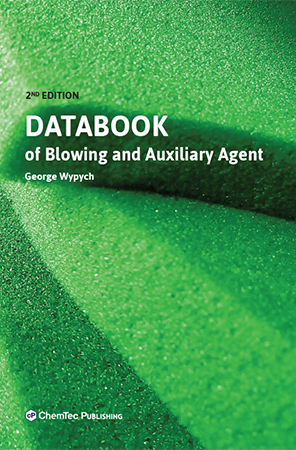This book is a must-have for manufacturers of blowing agents, manufacturers of products containing blowing agents designed for various purposes, regulating bodies, academia, and research laboratories. The databook contains information, which is complete, timely, up-to-date, and useful in numerous fields of application and for thousands of manufactures and products.
The Databook of Blowing and Auxiliary Agents is more useful in combination with the Handbook of Foaming and Blowing Agents. Both books do not overlap but complement each other.
The information on over 360 blow molding and auxiliary agents is presented in individual tables for each product (either commercial or generic). The data are divided into 5 groups, including General Information, Physical Properties, Health & Safety, Ecological Properties, and Use & Performance. The following information is included in each Section if available in the source(s) of data.
General Information: name, CAS #, EC #, IUPAC name, common name, common synonyms, acronym, empirical formula, chemical structure, molecular mass, RTECS number, chemical category, product class, product composition, masterbatch, blends, moisture content, solids content.
Physical Properties: state, odor, color, platinum-cobalt scale, bulk density, density, specific gravity, pKa, boiling point, melting point, pour point, decomposition temperature, maximum gas yield, total gas yield, TMA, blowing gas content, foam K factor, glass transition temperature, main gas, iodine value, aniline point, refractive index, vapor pressure, vapor density, vapor thermal conductivity, volume resistivity, relative permittivity, ash content, pH, viscosity, absolute viscosity, surface tension, solubility in solvents, solubility in water, the heat of vaporization, the heat of combustion, the heat of decomposition, specific heat, thermal conductivity, Henry’s law constant, particle size, and volatility.
Health & Safety: NFPA classification, HMIS classification, OSHA hazard class, UN Risk phrases, UN Safety phrases, UN/NA class, DOT class, ADR/RIC class, ICAO/IATA class, IMDG class, packaging group, shipping name, food approvals, autoignition temperature, self-accelerating decomposition temperature, flash point, TLV ACGIH, NIOSH and OSHA, maximum exposure concentration IDLH, animal testing oral-rat, rabbit-dermal, mouse-oral, guinea pig-dermal, rat-dermal, rat-inhalation, mouse-inhalation, ingestion, skin irritation, eye irritation, inhalation, first aid eye, skin, and inhalation, carcinogenicity IARC, NTP, OSHA, ACGIH, and mutagenicity.
Ecological Properties: atmospheric lifetime, biological oxygen demand, chemical oxygen demand, theoretical oxygen demand, biodegradation probability, aquatic toxicity algae, Rainbow trout, Sheepshead minnow, Fathead minnow, and Daphnia magna, global warming potential, ozone depletion potential, VOC, Kyoto compliant, and partition coefficient.
Use & Performance: manufacturer, product feature, recommended for polymers, recommended for products, outstanding properties, a typical reason for use, processing methods, not recommended for, the concentration used, food approval, and R-value.
Azodicarbonamides
Crosslinkers
Dinitroso pentamethylene tetramines
Dispersions in polymer carriers
Foaming agent mixtures with other additive(s)
Gases
Hydrazides
Hydrocarbons
Hydrochlorocarbons
Hydrochlorofluorocarbons
Hydrofluorocarbons
Hydrofluoroolefins
Masterbatches
Microspheres
Mixtures of foaming agents
Nucleating agents
Proprietary
Salts of carbonic and polycarbonic acids
Sodium bicarbonate
Sulfonylsemicarbazides
Tetrazoles
Water




